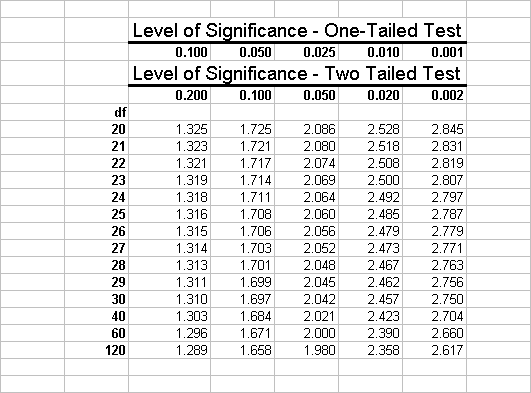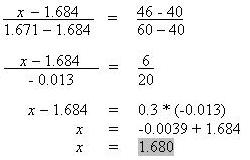Now we have to run our independent means t-test and make a conclusion based on our data. The t-value for this test is:
| Culture | Mean |
| Belize | 1142 |
| Samoa | 4824 |
| t-value | -2.46, df = 46 |
However, this value is difficult to interpret without some point of reference as to how probable it is to obtain such a value. To assess this probability, we compare our computed t-test value to a critical value. The critical value is a number based on the type of test (one tailed vs. two tailed), degrees of freedom, and alpha level. The critical value gives information regarding how probable a result would be, given that the null hypothesis was in fact true. Looking at t-distribution table we get the following values, let us assume we are using alpha =.05. Note: For larger values of degrees of freedom, most tables only give critical t-values for every tenth score.

To decide on the critical t value, the value against which we will compare our computed t-value, we need three pieces of information:
- 1. How many degrees of freedom do this test have?
-
Check Your Answer
(N1 – 1) + (N2 – 1), where N1 = # of cases (people) measured for Belize (24) and N2 = # for Samoa (24)
(24 -1) + (24 -1) = 46This often is represented more generally as the following (N – k), where N = the total number of people measured (48) and k = the number of groups (2).
(48 – 2) = 46 - 2. What is our alpha level?
-
Check Your Answer
Alpha is often an arbitrary level of comparison, usually either .05 or .01. In this problem we are instructed to use the .05 alpha level. Often in real analyses we choose this level ourselves.
- 3. Are we interested in a one tailed or two tailed test?
-
Check Your Answer
This is based on our hypothesis. For a one tailed test we want to conclude that one group is different than another in a predictable manner. For the one-tailed test we specify that we expect one group to be greater than another or the opposite. For a two tailed test we want to conclude that one group differs from the other but we make no attempt to predict the direction (i.e. greater or less than) of the relationship, we only say the groups are not equal.Or alternative hypothesis (what we want to conclude) specifies the direction of a relationship (Belize closer than Samoa), so we have a one tailed (aka directional test).
Based on these pieces of information, we can find the critical value. What is it?
Check Your Answer
The table we have does not list the critical value based on 46 dfs. Thus, we have to look at the next lowest dfs for a more conservative estimate of the critical t-value. The tabled critical t-value for df = 40, alpha = .05, one-tailed is 1.684. The actual critical t-value for df = 46 is 1.679, which is not as conservative as the tabled value. Critical t-values based on an exact dfs can be computed using special calculators. When such a calculator is not available, we can do a linear interpolation to find the critical t-value, which is shown below:
When the table does not provide critical t-values for the desired dfs, we can interpolate the critical value based upon the neighboring dfs in the table. In this case, the table lists the critical values based on df = 40 and df = 60 (1.684 and 1.671, respectively), but not for df = 46 (x):
|
df |
critical t |
| 40 | 1.684 |
| 46 | x? |
| 60 | 1.671 |
Solving for x,

The interpolated critical t-value is 1.680, which is close to the actual value of 1.679.
Ask the Expert
Note: For larger values of degrees of freedom, most tables only give critical t-values for every tenth score. If this is the case, you should use the next lowest degree of freedom reported. This is a conservative estimate of what the actual value is.
Based on our t-value, the tabled critical values, and our hypothesis, what do you conclude about our data?
Belize and Samoa are different
Incorrect. (There is a better answer available) Recall our hypothesis and our t-values:

The conclusion “Belize and Samoa” are different is not specifically stated in either of our hypotheses. Our null hypothesis states that Belize children are either further or as close as (equal to) Samoan children. The alternative hypothesis states that Belize children are closer to their mothers than Samoan children. Our conclusions need to come directly from the hypothesis that we endorse. Neither hypothesis states “Belize and Samoa are not different.”
This is the fundamental difference between one tailed and two tailed hypothesis tests. If we were doing a two tailed test (e.g. Null hypothesis: Belize and Samoa are equal) here, we would conclude that since our computed t value (absolute value) is greater than tabled value, we could reject this null hypothesis. However, since we are doing a one-tailed test we are interested not only in if the 2 groups differ, but also how the two groups differ.
You are on the right track – there is however, a more correct answer available.
Belize and Samoa are NOT different
Incorrect. Recall our hypothesis and our t values:

The conclusion “Belize and Samoa” are not different is not specifically stated in either of our hypotheses. Our null hypothesis states that Belize children are either further or as close as (equal to) Samoan children. The alternative hypothesis states that Belize children are closer than Samoan children. Our conclusions need to come directly from the hypothesis that we endorse. Neither hypothesis states “Belize and Samoa are not different.”
Children in Belize are not closer to their mothers than children in Samoa
Incorrect. Recall our hypothesis and our t values:

Here your t-values, when compared to the critical value and the direction of the relationship would point to the opposite conclusion. Here we see a relationship wherein the mean for Belize is much smaller than the mean for Samoa. When we perform a t-test on these data, we get a value that is greater than the critical value. Since the absolute value of t is greater than the tabled (critical value) and the relationship is the direction we expected (Belize < Samoa), in this case we would reject our null hypothesis.
Belize children are further from their mothers than children in Samoa
Incorrect. Recall our hypothesis and our t values:

| Culture | Mean |
| Belize | 1142 |
| Samoa | 4824 |
| computed t-value | -2.46 |
| tabled value (alpha = .05, df = 40) | 1.684 |
| actual value (alpha = .05, df = 46) | 1.679 |
(1) To reject a null hypothesis in favor of an alternative hypothesis (what we want to conclude) our computed t-value needs to exceed our tabled t-value and the relationship between variables needs to be in the correct direction. Our computed value of t=-2.46 has a greater absolute value than our critical value t(.05,df=46,1 tailed)=1.684, however, the direction of the relationship is such that children in Belize (mean = 1142) are actually closer to their mothers than children in Samoa (mean = 4824). This exemplifies the importance of paying attention to descriptive measures when drawing conclusions based on t-values. If you ignore the actual values present, you may draw the wrong conclusions.
(2) Additionally, the conclusion that Belize children are closer to their mothers than Samoan children is not specifically stated in either of our hypotheses. Our null hypothesis states that Belize children are either further or as close as (equal to) Samoan children. The alternative hypothesis states that Belize children are closer than Samoan children. Our conclusions need to come directly from the hypothesis that we endorse. Neither hypothesis states Belize children are closer than Samoan children (the null encompasses this option but also allows for the groups to be equal).
Belize children are closer to their mothers than children in Samoa
CORRECT! Your conclusion reflects that we are 1) able to reject the null hypothesis and 2) that you understand what the null hypothesis means. Good work
While hypothesis testing is the most common procedure for answering questions such as “are children in Samoa further from their mothers than children in Samoa?”, the use of confidence intervals or effect size measures in conjunction with hypothesis testing as a means to shed light on the phenomena discussed.
Ask the Expert
When deciding to reject or no reject a hypothesis there are several issues to consider. The first of which being obtaining the correct computed and tabled values. Our tabled value serves as a comparison point, above which we conclude, that if our null hypothesis were true, would be so unusual that we are lead to question the veracity of the assumption (null hypothesis). The computed t value provides us with a measure of how much our results deviate from what can be expected given the null hypothesis. If our computed value of t is great than the value existent in the table then we can reject our null hypothesis in favor of the alternative hypothesis (what we want to state).
![]()

